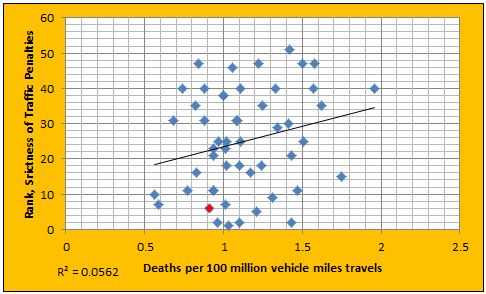I will concede this upfront: Bacon playing with statistics is like a toddler playing with a gun. Nothing good can come of it. With that word of warning, I ask readers to indulge me for a moment.
WalletHub, the financial advisory website, has come up with yet another listicle — a ranking of the 50 states (and Washington, D.C.) by the strictness of their speeding and reckless driving laws. This is a matter of more than passing interest to me because my son got his driver’s license just last week and my wife is a nervous wreck. Oh, no, it’s drizzling outside — the streets are dangerous. Oh, no, it’s bright and sunny outside — the glare can blind you. Readers who have had wives and teenage drivers know exactly what I’m talking about.
Back to WalletHub… It turns out that Virginia has the sixth strictest penalties in the country for speeding and reckless driving. Knowing the strictures put on teen drivers and drunk drivers, I can well believe that the traffic regimen is tough on speeders as well. But I asked myself a question that WalletHub didn’t answer: Do tough driving laws make a difference? Do they save lives, or do they just punish drivers for no reason?
In the spirit of social scientific inquiry, I compared the WalletHub ratings with data from the Insurance Institute for Highway Safety on the incidence of fatalities per 1 million vehicle miles traveled (VMT). The results can be seen in the chart above. The Y axis shows the WalletHub ranking, with the strictest states at the bottom and the most lenient states at the top. The X axis shows deaths per million VMT. The red dot shows Virginia.
Assuming I am analyzing the data properly (not something to be taken for granted), Virginia does seem to get some benefit from its strict speeding and reckless driving laws — but not as much as might be expected. The R², a measure of correlation, suggests that 5.6% of the difference in highway fatalities between states is explainable by the variation in speeding and reckless-driving penalties. That’s not a dominant determinant but a non-inconsiderable one. Yet the Old Dominion has the sixth strictest laws in the land but only the 11th lowest fatality rate.
Speeding enforcement and penalties are not the only means to reduce speeding. Other options include lower speed limits, road design and traffic-calming measures, and driver education, especially for young drivers. Other factors may come into play as well. Insofar as fatalities are correlated with driving speed, states with large rural populations driving on country roads may be at greater risk of fatalities, for instance, than largely urban states where city streets have lower speed limits. It is no accident that Washington, D.C. has a lower fatality rate per miles driven than any of the 50 states.
Could Virginia do a better job? My job is to ask the questions. Keener analytical minds are needed to come up with answers.



